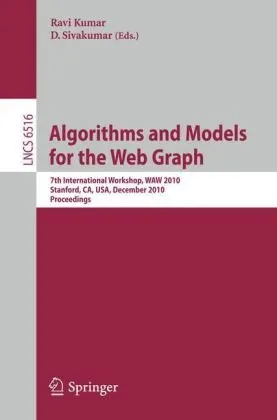Algorithms and Models for the Web-Graph: 7th International Workshop, WAW 2010, Stanford, CA, USA, December 13-14, 2010, Proceedings
4.5
Reviews from our users

You Can Ask your questions from this book's AI after Login
Each download or ask from book AI costs 2 points. To earn more free points, please visit the Points Guide Page and complete some valuable actions.Introduction
The book Algorithms and Models for the Web-Graph: 7th International Workshop, WAW 2010, Stanford, CA, USA, December 13-14, 2010, Proceedings provides an in-depth look at the most recent advances in the analysis and understanding of web graphs—a fundamental aspect of the modern internet landscape. Web graphs, which model the web as nodes (web pages) connected by edges (hyperlinks), display highly complex and dynamic behaviors, and their intricate structures have inspired both theoretical research and practical applications.
This book serves as the official proceedings for the 7th International Workshop on Algorithms and Models for the Web-Graph (WAW 2010), gathering contributions from leading researchers in the field. The purpose of this workshop and the book itself is to present innovative methodologies, algorithms, and mathematical models that help us better comprehend the web's topology, its underlying patterns, and how they influence web search engines, ranking systems, and similar technologies. Professionals, researchers, and students will find this book immensely valuable as it encapsulates both groundbreaking ideas and tried-and-tested algorithms.
Detailed Summary of the Book
At its core, this book explores the dynamic interplay between algorithms, graph theory, and the internet's structure. The workshop gathered contributions across diverse academic and practical topics, compiled into a cohesive volume. The chapters address issues central to understanding the web graph, such as node ranking strategies, link prediction, web crawling efficiency, and clustering algorithms. Moreover, it dives into statistical properties of web graphs, including their degree distribution, diameter, and small-world phenomena, which collectively shape the way we process and interact with massive datasets online.
The book also delves into specialized topics, such as modeling growth mechanisms of web graphs, the influence of social networks on link structures, and the construction of search algorithms optimized for large-scale networks. Throughout these discussions, the contributors use rigorous mathematical techniques and computational experimentation to arrive at their conclusions. Each chapter builds upon the foundations set by earlier research in the field, effectively providing a roadmap of how this domain has evolved and where it is headed.
Written with clarity and precision, the book balances theory with practical insights, making it accessible to both theoreticians with an interest in graph theory and practitioners who develop tools for navigating and optimizing web platforms.
Key Takeaways
- The web graph exhibits unique properties like small-world networks, power-law degree distributions, and clustering, which must be considered when designing effective algorithms.
- Link analysis and ranking algorithms, such as PageRank, are deeply rooted in our understanding of graph structures.
- Studying the evolution of web graphs helps us predict trends in user interaction and content creation on the web.
- Mathematical modeling and computational tools are vital for tackling the scalability challenges inherent in analyzing massive graphs.
- The intersection of web graphs and social networks provides new opportunities to enhance applications like recommendation systems and content discovery.
Famous Quotes from the Book
Here are a few thought-provoking excerpts from the contributors’ discussions in the book:
"The structure of the web graph provides the backbone for modern information retrieval systems, showing that even in its vastness, the web is fundamentally navigable."
"Understanding the dynamic nature of the web graph is not merely an academic pursuit; it is the key to designing algorithms that scale effectively in response to constant change."
"Graphs give us a way of modeling relationships at scale, and nowhere is this more evident than in the web, where trillions of connections tell the story of human knowledge."
Why This Book Matters
In an era where the internet dominates how we communicate, gain knowledge, and conduct business, understanding its structural foundations is critical. This book is a vital resource for anyone seeking a deeper comprehension of web graph algorithms and their applications in a real-world internet setting. Whether you're a web developer aiming to build more efficient search engines or a researcher delving into the theoretical aspects of large-scale graph analysis, this book bridges the gap between foundational research and its practical implementation.
The significance of WAW 2010 cannot be understated. As one of the earliest dedicated workshops on web graph analysis, its proceedings reflect cutting-edge work from leading minds in the fields of mathematics, computer science, and network engineering. As such, this book captures an important moment in the history of web graph research, offering insights that remain applicable today, even as the web continues to expand and evolve.
Equipped with a robust framework of theories, algorithms, and models, readers can use this book to tackle pressing challenges in graph analytics, ranging from web crawling and search optimization to understanding the role of nodes and connections in social networks. The ideas presented here continue to influence and inspire new research, cementing the book's place as a cornerstone in the study of web graphs.
Free Direct Download
Get Free Access to Download this and other Thousands of Books (Join Now)
For read this book you need PDF Reader Software like Foxit Reader


